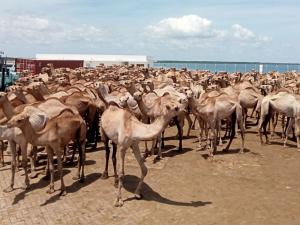
Second livestock export to Oman leaves Kenya's Lamu port
The second batch of livestock transshipment to the Port of Salalah in Oman finally left the Lamu Port in Kenya over the weekend aboard MV Banyas 1 after a month of waiting to assemble the animals.
MV Banyas 1, a Togolese specially designed livestock carrier vessel docked at the Port of Lamu on November 4 to ferry the animals, among them camels, bulls, sheep and goats.
Lamu Port Cargo Operations Manager Peter Masinde on Monday confirmed the ship had set off for Oman on Saturday afternoon with 2,955 live animals, a journey that is expected to take one week.
Out of the 2,955 animals, 663 are camels, 375 are bulls, 867 are sheep and 1,050 are goats.
Initial reports from the Lamu Port Management had, however, indicated that over 7,000 livestock including 1,000 camels, 300 bulls, 6000 goats and sheep were to be ferried to Oman in the second transshipment.
Hay and silage
Mr Masinde said apart from the live animals, MV Banyas 1 also ferried 2,491 bags of hay and silage to Oman in the second transshipment.
“MV Banyas 1 left Lamu Port for Oman on Saturday at 2pm. We expect the ship to dock at the Port of Salalah in Oman within six to seven days,” said Mr Masinde.
He cited transport hitches, especially for big animals like camels and bulls assembled from far-flung Kenyan counties of Garissa and Wajir to the Lamu port as a major cause of the delay in loading of the animals for transshipment.
Mr Masinde asked livestock keepers in counties with high animal populations to invest heavily in the transport sector to ease the ferrying of camels and bulls to the Lamu port.
Leading counties
Mandera, Turkana, Wajir, Garissa, and Marsabit counties are leading with the highest camel population in Kenya and the Lamu port’s live animal export business to Oman is highly dependent on them.
These counties are, however, a far distance from the Lamu port, with most of them not less than 250 kilometres away.
“It is the high time that livestock keepers invest in special trucks and lorries to ferry animals to the Lamu port. Many camels bought all the way from Garissa and Wajir had to be brought to the Lamu port on foot which is time-consuming. The livestock market is now here with us but the challenge is on how the big animals bought from far-flung counties can reach the port [quickly] for loading to Oman,” said Mr Masinde.
Invest in hay production
He also advised hay and silage producers to embrace the activity as the demand for animal feeds at Lamu port continues to rise .
Lamu is producing hay and silage, though at a low rate with Laikipia and Narok counties supplementing the production.
“Hay and silage is currently a nice venture. A simple bale of hay goes for not less than Sh300 ($2.44) at the Lamu port,” said Mr Masinde.
On his side, Lapsset Coast Regional Manager Salim Bunu noted that the ongoing shipment of live animals from Kenya to Oman via the Lamu port is crucial as that alone will alleviate losses for pastoralist communities where harsh climatic conditions have led to the deaths of livestock.
“Sincerely speaking, the livestock export business to Oman through the Lamu port is providing the much-needed relief for pastoralists amid an unprecedented drought crisis,” said Mr Bunu.
During the first transshipment where MV Banyas 1 transported at least 16,000 live animals including cows, goats and sheep from the Lamu port in October this year, it took only one week to assemble the livestock .
The ship docked at the Lamu port from the Suez Port in Egypt on October 14and left for the Port of Salalah in Oman on October 21.
https://www.theeastafrican.co.ke/tea/business/kenya-exports-livestock-to...
